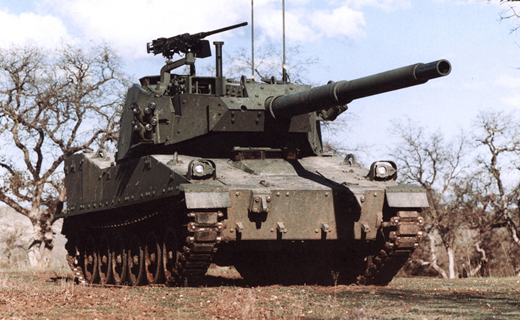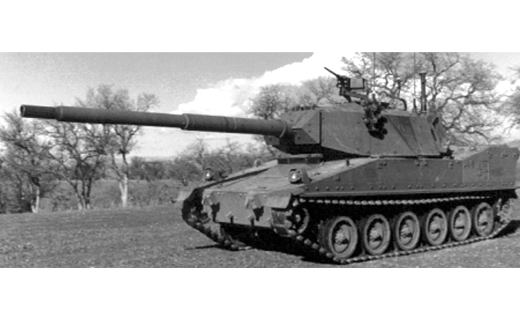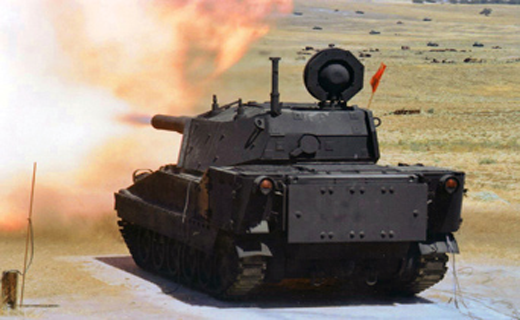Strike Now: Why the Armored Gun System Must Be Purchased in This Fiscal Climate




The proposed Fiscal Year 2015 Department of Defense budget released Feb. 24, 2014, is dismal. Both services and branches stand to lose projects, formations and personnel as funding is restricted, but the Armor Branch does not have to. We have the ability to exploit the political terrain.
Secretary of Defense Chuck Hagel, during the budget press conference, stated that ground forces should be able to support air and naval forces against an adversary and focus on developing the next-generation vehicle platform.1 Defense and Army leadership over the last few years continue to stress the need for a rapid and flexible deployable force that can be used in anti-area denial and access scenarios.2 Currently the Army does not have an armored platform that fits that need. However, a platform that can be rapidly deployed by air in support of infantry conducting joint-operation access already exists. It is the X-M8 or Armored Gun System (AGS).
A history
Until 1997 and the closing of 3-73rd Armor Regiment (Fort Bragg, NC), the Army had a light armor capability in the M551 Sheridan. The tank proved its effectiveness in Vietnam in direct support of infantry. Its smaller size proved effective in Vietnam’s restrictive terrain. Most importantly, 3-73rd distinguished itself in two events during Operation Just Cause. First, it conducted a successful air land with one platoon into Howard AFB, Panama. The second was a heavy drop of 10 Sheridans in support of 1st Brigade, 82nd Airborne. Eight Sheridans remained operational after the drop and provided more firepower for the brigade and conducted traditional cavalry operations. The Sheridan provided the commander flexibility and showed a true combined-arms team.3
Again, the Sheridan’s size and direct-fire capability (152mm) proved effective as combat moved into the restrictive areas of Panama City. Due to the rules of engagement in Panama City, the Sheridan was the platform that light infantry relied on for accurate and timely fire; aviation and indirect fires were less effective on an entrenched enemy in the dense urban environment.4
The Sheridan was slated to be phased out and replaced with a new AGS. The initial development started in 1978 and continued until a contract was awarded in 1992 to FMC Corporation. Critical design requirements included the need for the platform to 1) be deliverable by low-velocity air drop; 2) use a XM35 105mm as its main gun (with auto-loader); and 3) be able to fight immediately after de-rigging. All tactical heavy-lift aircraft in the inventory could deliver the platform: C-130s could carry two, C-17s could carry three and C-5s could carry five platforms.5
The AGS was titled the XM-8. It also carried a M2 machinegun for the tank commander and a 7.62 coax machine gun. The XM-8 had a three-man crew, a ground speed around 45 mph and an estimated 300-mile cruising range on a 150-gallon gas tank. Perhaps most importantly in a fiscally austere environment, the XM-8 was designed with multiple parts already in the Army supply system. The power supply was a modified Heavy Expanded Mobility Tactical Truck, or HEMTT, engine, and the power-control handles and transmission were the same as a Bradley. Additional passive armor can be added onto the vehicle and comes in three stages, with Level I (the lightest level) intended for airborne operations.6 Today more modifications to the XM-8 would have to be specified by the Army, drawing from 13 years of conflict in Iraq and Afghanistan.
The AGS was designed to support airborne or light infantry in contingency operations, either during seizure of an airfield or roll-off operations (air-land) and support of ground force in a combined-arms roll providing lethality and maneuver.7 The XM-8, like the Sheridan, gave the infantry direct-fire support in combination with other fires provided by close air support (CAS) and close-combat attack (CCA). It would also allow for precision direct fires on targets that may be surrounded by sensitive and high-collateral damage areas, something that cannot be guaranteed by air platforms. As an all-weather platform, it can also guarantee continued support if CCA, CAS and unmanned aerial vehicles are degraded by weather.
The U.S. Army purchased six XM-8s and began testing them in the early 1990s. The XM-8 was canceled in 1996 due to budget restraints, leaving the Army without a rapidly deployable armor package and infantry without direct fire support.8,9
Continued need
The question and need for mobile firepower was again raised to Armor Branch by the current 82nd Airborne Division commander, MG John W. Nicholson Jr. He succinctly sums up the capability gap that currently exists for one of the U.S. Army’s main missions: “The idea of having mobile protective firepower that can be delivered by air – whether air drop or air land – and get into the fight immediately enables us to retain the initiative we gain by jumping in. But if all we’re doing is jumping in and then moving at the speed of a World War II paratrooper, we’re going to rapidly lose the initiative we gained by conducting a strategic or operational joint forcible entry. If we instead get a force on the ground that’s mobile and has firepower, we can retain that initiative and achieve decisive results against the enemy.”10
This type of mobile and lethal force with multiple methods of infiltration behind enemy lines is the true essence of the cavalry concept. This capability added to an airborne unit is a strong deterrent to our nation’s enemies and a powerful diplomatic weapon for any U.S. president. A true combined-arms team would be deployable anywhere in the world in 96 hours. Imagine the psychological and physical effect on the enemy if a force of AGS was successfully parachuted into an enemy area to disrupt and destroy targets of opportunity.
Employment
There are multiple ways the XM-8 could be incorporated into today’s combat formations. MAJ Martin Stanton in a 1994 ARMOR article recommended building assault gun battalions with three AGS companies, totaling 44 weapon systems (two for battalion headquarters and 14 per company). The companies would be manned and equipped like a standard heavy tank company. Stanton recommends that each airborne or light division receive an assault gun (AG) battalion with three AGS companies.11
I believe that if approached from a battalion concept, planning should start with four battalions. One battalion would be positioned at Fort Bragg to support 82nd Airborne Division with one company for each brigade. A second battalion would be stationed at Fort Benning, GA, to support 75th Ranger Regiment and other Special Operations Forces. A third battalion would support 173rd Airborne Brigade, and a fourth battalion would be positioned in Alaska to support 4-25th Airborne Brigade and operations in the Pacific. These battalions would fall under a regimental headquarters, providing oversight and training guidance, and be co-located with one of the battalions. This would provide the Army with a total of 12 AG companies and approximately 176 AG platforms.
However, with fiscal constraints and to meet the Secretary of Defense’s intent, a more tailored approach could be feasible with seven AG companies – or about 98 AG platforms. Each airborne brigade combat team (BCT) would receive an AG company, allotting three to Fort Bragg and one to 173rd. This would at minimum task-organize a platoon of XM-8s to an airborne battalion as necessary. In this scenario, an Alpha or Bravo cavalry troop would be replaced in the squadron with an AGS company. This would give the airborne BCTs a versatile formation, with one squadron controlling a motorized scout troop, an AGS company and a dismounted scout troop. This organic relationship would also allow a closer working relationship with the AGS company, scouts and infantry.
One company would be added to the regimental special-troops battalion (RSTB) to support Special Operations Forces and 75th Ranger Regiment. With the “Pacific rebalance,” it would make sense to add two AG companies to the airborne cavalry squadron in 4-25th Airborne BCT. Any scenario still allows the brigade commander to tailor his combined-arms force as he sees necessary (see Figure 4).
Conclusion
Compromising the maneuverability and lethality of the forcible/joint entry forces should never have been allowed when the Army canceled the XM-8 in 1996, but this platform is critically needed today as joint forces look for a light and lethal force. This smaller tank provides a critical gap during the time it takes to move main battle tanks into a theater. The XM-8 has already been designed, saving time and money, and only needs to be upgraded to take advantage of almost 20 years of technological advances and 13 years of conflict.
The Secretary of Defense wants to see what future vehicle concepts look like. The XM-8/AGS is the answer. The addition of this tank would provide an armored fist anywhere in the world, as well as a true armored-cavalry shock force against the nation’s enemies.
Notes
1 McLeary, Paul, “Hagel: Ground forces can fight in one theater, support air, sea forces in another,” Army Times, Feb. 24, 2014; http://www.armytimes.com/article/20140224/NEWS05/302240038/Hagel-Ground-forces-can-fight-one-theater-support-air-sea-forces-another.
2 Wright, Dave E. LTC, “Mechanized Cavalry Groups: Lessons for the Future of Reconnaissance and Surveillance,” School of Advanced Military Studies (SAMS) monograph, U.S. Army Command and General Staff College, Fort Leavenworth, KS, May 5, 2013; http://cgsc.contentdm.oclc.org/cdm/ref/collection/p4013coll3/id/3006.
3 Thompson, Burdett K. MAJ, “Where’s the Light Armor? Enhancing the Firepower of Early Entry Forces,” SAMS monograph, U.S. Army Command and General Staff College, Fort Leavenworth, KS, Dec. 13, 1996; http://cgsc.cdmhost.com/cdm/ref/collection/p4013coll3/id/1001.
4 Mosher, Alan M. MAJ, “Light Armor MOUT Doctrine: Imperative Change or Business as Usual?,” SAMS monograph, U.S. Army Command and General Staff College, Fort Leavenworth, KS, Dec. 17, 1993; http://cgsc.cdmhost.com/cdm/ref/collection/p4013coll3/id/1349.
5 www.military-today.com/tanks/m8_buford.htm.
6 Nagl, John CPT, “Sheridan Replacement Offers Better Firepower, Plus Worldwide Mobility,” ARMOR, July-August 1992.
7 U.S. Army Training and Doctrine Command Systems Manager for Armored Gun, “The Armored Gun System,” ARMOR, March-April 1992.
8 Stanton, Martin N. MAJ, “Assault Gun Battalion 96,” ARMOR, September-October 1994.
9 Cameron, Robert S. Dr., To Fight or Not to Fight?: Organizational and Doctrinal Trends in Mounted Maneuver Reconnaissance from the Interwar Years to Operation Iraqi Freedom, Combat Studies Institute Press: U.S. Army Combined Arms Center, Fort Leavenworth, KS, 2013.
10 “From the Chief of Armor’s Turret,” Thunderbolt Blast (Armor School newsletter), Vol. 2, Issue 9, December 2013-January 2014.
11 Stanton.
 email
email print
print